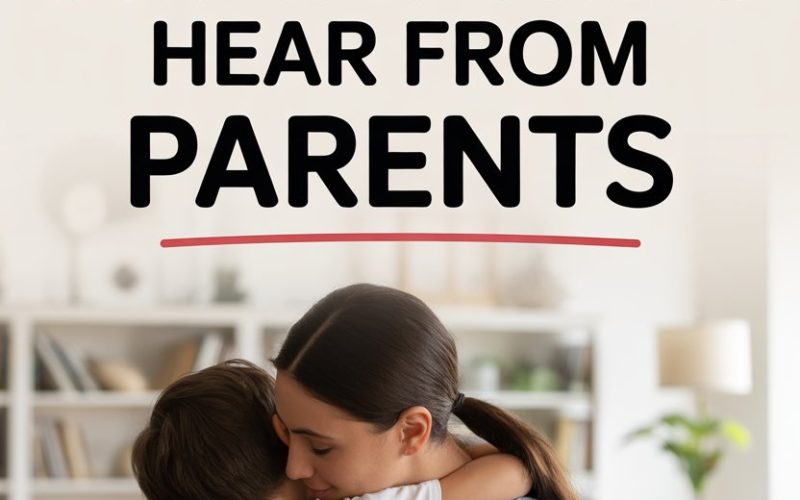Ever wish your child would just tell you what’s wrong instead of slamming the door and communicating through a series of heavy sighs?
Emotional intelligence isn’t just about identifying feelings; it’s about knowing what to do with them.
And as much as we’d all love a magic script, emotional smarts in kids often start with what they hear from us—sometimes in the heat of a tantrum, sometimes at bedtime, sometimes while we’re wrestling a Peppa Pig sticker from the dog’s foot.
What parents say (and how they say it) can hardwire a child’s ability to understand, handle, and express feelings for life.
Below, you’ll find the phrases, approaches, and attitudes emotionally intelligent children are soaking up right now from parents who are—let’s be honest—muddling through just like the rest of us.
Words for All the Big Feelings
Kids are like tiny volcanoes: calm, bubbly, then suddenly there’s lava on the curtains.
One of the most quietly revolutionary things parents of emotionally smart kids say? They give names to feelings, even the ones we’d rather ignore.
Picture it: “You look frustrated because your block tower fell down. That happens, and it’s really annoying.” Or, “Are you sad because your friend left? I get sad when goodbyes happen too.”
Naming the emotion doesn’t just bring comfort—it hands kids a vocabulary for their inner world.
This isn’t just fluff— Studies from International Journal of Child Care and Education Policy show that children who can identify feelings in themselves and others are better at self-regulation, learning, and relationships.
Basically, fewer meltdowns in aisle six.
Empathy In Action
It’s not only what you say, it’s how you show it. Emotionally attuned parents listen, nod, and say things like, “I can see that hurt your feelings” or “I get why you’re so excited.”
Real empathy isn’t just saying “I understand.” It’s showing it, right in the moment, in a way that matches your child’s energy.
No, you don’t have to break into interpretive dance every time someone cries, but acknowledging your child’s emotional reality tells them loud and clear: Your feelings are real. I’m here with you.
According to research published in Child Development, kids who receive empathy from caregivers develop more resilience and are even kinder to their mates.
It’s Okay To Feel…Anything
There’s a subtle magic in hearing your parent say, “It’s okay to feel angry. It’s not okay to hit.” Or, “Feeling scared is normal. How can I help you feel safe?”
These words let kids know their feelings aren’t ‘bad’ or something to hide under the rug with the week-old Cheerios.
This approach helps kids avoid shame spirals and learn that emotions are just messengers, not monsters.
Even better, it sets them up for emotional honesty later—yes, even in the teenage years, when grunting is the main form of communication.
Modelling The Messy Bits
Kids notice everything—especially when we’re trying to keep it together after stepping on Lego barefoot (a true test of character).
Parents who raise emotionally savvy kids don’t pretend to be robots. Instead, they own their feelings: “I’m really tired today, so I might be a bit grumpy. I’m going to take a few deep breaths.”
This isn’t weakness; it’s leadership. Children learn that grown-ups have feelings too, and managing them takes effort.
No need to overshare (“Mummy is stressed because the tax office sent another letter…”), but a little transparency builds trust.
Harvard’s Center on the Developing Child notes that kids who see adults managing emotions in healthy ways are more likely to do the same.
Problem-Solving Together
It’s tempting to fix everything for our kids.
Who hasn’t wanted to march up to the playground and negotiate a peace treaty over the swing set? Yet emotionally intelligent families focus more on helping kids develop their own coping and problem-solving skills.
This sounds like: “You’re upset your friend took your toy. What do you think we could do?” or “Sometimes when I feel left out, I try to join in another game. Should we try something together?”
Instead of rush-to-the-rescue, parents are acting as co-pilots—available for advice, but letting kids take the wheel when they can (with seatbelts buckled, obviously).
Making Repair A Habit
We all mess up. Maybe you snapped at bedtime or rolled your eyes at a story about Minecraft sheep.
Emotionally smart parents show kids how to apologise and make repairs. “I yelled earlier, and that wasn’t fair. I’m sorry. Can I have a do-over?”
Apologies aren’t just for fixing hurt feelings—they model humility and teach kids how to mend relationships after conflict. This is pure gold for future friendships, school life, and, dare we say, surviving group projects.
The Gottman Institute highlights that “repair attempts” are crucial for relationship health, not just in marriages but in families too.
Encouraging Emotional Independence
“Do you need a cuddle, or do you want some space?” This simple question hands the emotional toolkit over to the child.
Emotionally wise parents are constantly encouraging autonomy. Not, “Stop crying, you’re fine,” but, “Would you like some time alone or want to talk about it?”
This respects a child’s ability to know their own needs—and gives them practice making choices about their wellbeing.
Kids who get these chances turn into adults who can say “no” when they need to, set boundaries, and ask for help without shame.
Validating, Not Fixing
It’s human nature to try and fix things for our kids, but emotionally attuned parents have mastered the art of simply being present.
Instead of offering solutions right away, they say, “That sounds really hard,” or “I’m here if you want to talk.”
This doesn’t mean standing silently while your child does a full-body pancake on the floor, but pausing before jumping into “Here’s what you should do…” can work wonders.
Sometimes kids don’t want solutions—they want solidarity.
As clinical psychologist Dr. Becky Kennedy puts it, “Validation builds connection, even when nothing is ‘solved’.”
Using ‘I’ Statements and Clear Communication
Instead of “You’re being naughty” or “Why are you like this?” emotionally healthy households hear “I feel worried when you run off at the shops because I want you to be safe.”
‘I’ statements put the focus on feelings and actions, not character or blame. This helps kids see the impact of behaviour without feeling shame or defensiveness.
They’re more likely to listen (eventually), and the conversation stays open instead of spiralling into a shouting match.
Inviting Emotional Conversations—Anytime, Anywhere
Your child’s most profound conversation about sadness might happen while scraping mashed potato off the ceiling, not at a formal ‘feelings time’.
Emotionally smart parents weave emotional literacy into everyday life: “How did it feel when you scored that goal?” or “I noticed you went quiet after your friend left—what was that like?”
No need for daily family therapy sessions. Just little invitations, again and again, that say: Talking about feelings is normal in this house.
raisingchildren.net.au recommends using books, stories, and even TV scenes as springboards for conversations about feelings.
Humour as a Pressure Valve
Yes, emotion is serious business, but a little playfulness can be the secret ingredient. Emotionally wise families use humour to defuse tension and to show that feelings aren’t scary or forbidden.
A well-timed joke (or, for the brave, a silly face contest) can turn a brewing storm into a giggle fest.
Just be careful not to use humour to brush off real distress—think of it as a gentle breeze, not a leaf blower.
Laughter helps children see that feelings can change, and that even bad moods have a beginning, middle, and end.
Emotional Intelligence Grows at Home
There’s no perfect script, and every family has days when the only emotion going around is “Please just go to sleep.”
But when kids hear words that name feelings, show empathy, encourage independence, and model repair, they’re picking up the tools they’ll use for the rest of their lives.
Next time your child is melting down, or just quietly building a Lego universe, try one of these phrases out loud.
You might just hear something amazing in return—a feeling named, a need voiced, a tiny human learning how to be big-hearted.
That’s the kind of noise every parent wants in their house. Even if it comes with the occasional door slam.





